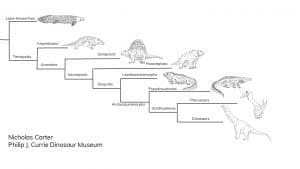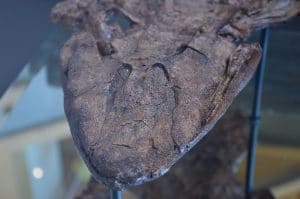
Is your favourite dinosaur the sail-backed Dimetrodon? Or is it one of the wonderful flying pterosaurs? Or maybe it’s one of those sea-going dinosaurs, perhaps a type of long-necked plesiosaur or a shark-like mosasaur? If you’d say any of these are your favourite dinosaur, I have sad news- these creatures, though wonderful in their own right, are not dinosaurs.
Hopefully I didn’t lose any paleontology specialists there.
Instead of the usual thing where we go through the list and name off famous fossil creatures that are not dinosaurs, I’m going to illuminate what scientists mean by the word ‘dinosaur’. Casual dialogue, especially in the media, tends to use ‘dinosaur’ to mean any (usually big and ferocious) extinct animal. This implies as well that dinosaurs, by definition, can’t still be alive (and preferably not small and timid). However, the word ‘dinosaur’ is not a vague label for any extinct monster, but a scientific name to describe a group of animals, many of which are extinct, some of which were big and ferocious, and all descended from one common ancestor. So let’s trace the ancestry of dinosaurs from a broad sense and get more specific, so that we’ll know exactly what we mean by that term.

A simplified evolutionary tree showing the diversity of vertebrate groups leading up to dinosaurs. Image by Nicholas Carter
First off, dinosaurs are animals. This might seem obvious, but it’s important to remember that no matter how monstrous or far in time they might seem, they were animals who lived their lives as modern animals do today. Most animals are invertebrates, but dinosaurs belong to a special group that evolved an internal skeleton, most notably a spinal column. They’re vertebrates, just like you and I. All vertebrates descended from one common ancestor, a species of little fish with a flexible rod in its back, hundreds of millions of years ago.
For a while the only vertebrates were fish, but by the late Devonian Period (about 367 million years ago) some fish with bones in their fins started to flirt with the idea of life on the land. It was a long and complicated process going from the water to the land, involving rearranging the skeleton and sensory organs for the challenges of terrestrial life, but in this far-off time the first four-legged land animal was born. This was the first tetrapod, and all vertebrates that aren’t fish are descended from it. For a while, all tetrapods still depended on the water to some degree or other. For one thing, they still had to lay their eggs in it or else they would dry out. One lineage of these semi-aquatic early tetrapods eventually went on to spawn our modern amphibians. Others developed less and less dependency on the water, developing scaly skin and a hard-shelled egg that contained everything the developing young needs to survive. These were the first amniotes, named for that egg in which is found the protective amnion layer. Living amniotes include lizards and snakes, crocodiles, birds, turtles, and mammals (yes, mammals- though most of us don’t lay eggs anymore, we used to, and a few rare mammals still do), but many interesting fossil amniotes have come and gone throughout history.

The wonderful fossil fish Tiktaalik. This creature existed along the continuum between fishes and land animals. Photo by Nicholas Carter
One lineage of amniotes developed a single hole, the temporal fenestra, in each side of the skull behind the eye sockets. These were the synapsids, which include the reptile-like ‘stem mammals’ (including our old friend Dimetrodon) as well as true mammals. So congratulations, you’re a synapsid! Another lineage of amniotes either developed no temporal fenestrae at all, or they developed two on each side. This lineage is known as the sauropsids, a preferred modern name for the misleading term ‘reptile’. Sauropsids that never got around to acquiring temporal fenestrae were the parareptiles, and they all went extinct before the dinosaurs even appeared, so we won’t worry too much about them right now. The amniotes that went full-on with two temporal fenestrae are the diapsids. The diapsids themselves also went off in two separate evolutionary directions. Some stayed relatively small with a sprawled-out posture and low metabolic rate. These are the lepidosauromorphs, and modern lizards (including snakes plus the giant prehistoric mosasaurs) are a part of this lineage, as is the ancient, noble tuatara. The marine plesiosaurs and turtles might also be lepidosauromorphs, but could also be a part of their twin lineage, the archosauromorphs. Turtle evolution is a confusing mystery that most palaeontologists don’t get into.
The archosauromorphs tend to be more elevated in their body posture and metabolism than the lepidosauromorphs. Keeping their legs underneath them and their tails off the ground helped them get around quicker and find food easier. Archosauromorphs include the crocodiles and their ancestors, the flying pterosaurs (‘pterodactyls’ to the layperson), and the dinosaurs. You’ll notice we’ve also eliminated the notion of dinosaurs being ‘giant lizards’. Dinosaurs and pterosaurs are more closely related to each other than either is to crocodiles, and the clues for this are actually in the ankle joint- in the crocodile lineage (Pseudosuchia) the joint is formed by a complicated interaction between the ankle bones, but in dinosaurs and their kin (Ornithodira) it’s a fairly straightforward hinge between the leg and ankle bones and the foot bones.

The skull of the tyrannosaurid dinosaur Gorgosaurus, showing off those temporal fenestrae, plus the distinctly archosaurian antorbital fenestra- that’s the triangular hole between the nose and eyes. Photo by Nicholas Carter
So what distinguishes the dinosaurs from the pterosaurs and the other odds-and-ends species in that family tree? Well, it all comes down to some pretty specific anatomy. Certain characteristics in the bones that all dinosaurs share, and inherited from one common ancestor- the first dinosaur. These anatomical traits include an open hip socket, relatively straight leg bones that always prop the creature up, a (more-or-less) s-shaped neck, and certain ridges or ‘crests’ on the limb bones for special muscle attachment. These features might not seem significant, but they unite all dinosaurs within one evolutionary grouping of species. This is usually defined as the group that contains Triceratops, the house sparrow (Passer domesticus), the common ancestor of these two wonderfully different creatures, and all of its dinosaurian descendants that have come and gone through the ages. It’s often said in palaeontology media, but it bears repeating that all birds that have ever lived fall under this grouping. Not just the more typically ‘dinosaur-y’ looking ones, but ALL birds, because all birds living and extinct are descended from one common ancestor, which itself was a small feathery dinosaur. Your backyard chickadees and finches, exotic parrots and egrets, and barnyard chickens are all just strange, highly modified dinosaurs, because they share all the necessary traits inherited from that very first dinosaur back in the Triassic times.
There’s many, many more ways to divide up the dinosaurs into more specific and less inclusive groups. You have your ornithischians and saurischians, ornithopods and sauropodomorphs, and your genasaurs and coelurosaurs. But we won’t trace the lines of descent, this Mesozoic War of the Roses, any further. But hopefully this helps to illustrate exactly why those of us in the dinosaur business are so specific when we determine what is and isn’t a dinosaur. Hopefully we’ve also shown just a hint of the vast, wonderful diversity of life that has come and gone before humans arrived, and the never-ending struggle we’ve undertaken of making sense of it all.
By Nicholas Carter
